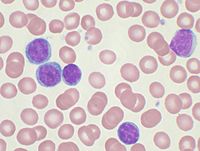
Photo from wikipedia
Introduction: Burkitt’s lymphoma (BL), an aggressive kind of non-Hodgkin’s B-cell lymphoma. On the other hand, appendiceal carcinoid tumors are uncommon neuroendocrine neoplasms. Case presentation: The authors report a case of… Click to show full abstract
Introduction: Burkitt’s lymphoma (BL), an aggressive kind of non-Hodgkin’s B-cell lymphoma. On the other hand, appendiceal carcinoid tumors are uncommon neuroendocrine neoplasms. Case presentation: The authors report a case of a 15-year-old Syrian adolescent who was admitted to our hospital due to a persistent, severe generalized abdomen pain accompanied by nausea, vomiting, loss of appetite, and inability to pass stool or gas. An abdominal radiograph revealed dilated intestinal loops with air-fluid levels. The patient underwent emergency surgery through which a retroperitoneal mass was removed as well as part of the ileum and the appendix. The final diagnosis was consistent with intestinal BL associated with an appendiceal carcinoid tumor. Discussion: The correlation between gastrointestinal carcinoids and other types of tumors was frequently reported. However, there have been few reports of carcinoid tumors being associated with lymphoreticular system cancers. BLs were classified into three variants: endemic, sporadic, and acquired immunodeficiency-associated BL while appendiceal neuroendocrine tumors were classified as the following: well-differentiated neuroendocrine tumors with benign or uncertain malignant potential; well-differentiated neuroendocrine carcinoma with low malignant potential; and mixed exocrine-neuroendocrine carcinoma. Conclusion: Our article demonstrates an unusual association between BL and an appendiceal carcinoid tumor that highlights the significant role of histological and immunohistochemical staining in confirming the diagnosis, as well as the role of surgery in treating the complications of intestinal BLs.
Journal Title: Annals of Medicine and Surgery
Year Published: 2023
Link to full text (if available)
Share on Social Media: Sign Up to like & get
recommendations!